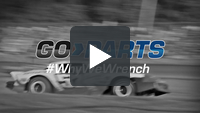The Dodge Magnum bumper cover is a vital component that enhances the vehicle's exterior appearance and aerodynamic performance. Serving as the outer shell of the bumper assembly, it covers and protects underlying parts such as impact absorbers and reinforcement bars. The bumper cover contributes to the sleek design of the Dodge Magnum while providing minimal protection against minor impacts and road debris.
Over time, the bumper cover of a Dodge Magnum may experience wear and tear due to various factors. Common issues include scratches, cracks, dents, and fading paint caused by minor collisions, exposure to harsh weather conditions, or contact with road debris. A damaged bumper cover can affect the vehicle's aesthetics and may lead to further deterioration if not addressed promptly.
Replacing a damaged or worn-out bumper cover is essential to maintain the appearance and integrity of your Dodge Magnum. When selecting a replacement, ensure it is compatible with your specific model year for proper fit and function. Opting for a high-quality bumper cover made from durable materials can provide better longevity and resilience against future damage.
Installing a new bumper cover on your Dodge Magnum involves several steps:
Preparation: Gather all necessary tools, including screwdrivers, wrenches, and clips. Park the vehicle on a flat surface and disconnect the battery if needed.
Removal: Carefully remove the old bumper cover by unfastening screws, clips, and bolts. Be cautious not to damage adjacent components like headlights or grilles.
Transfer Components: If applicable, transfer accessories such as fog lights, grilles, or moldings from the old cover to the new one.
Installation: Align the new bumper cover with the vehicle's mounting points. Secure it in place using the original hardware, ensuring all clips and bolts are tightened properly.
Final Checks: Verify that the bumper cover is aligned correctly and that all connected components function as intended.
Professional installation is recommended if you are uncertain about the process to ensure the bumper cover is fitted securely and accurately.
Preparation: Gather all necessary tools, including screwdrivers, wrenches, and clips. Park the vehicle on a flat surface and disconnect the battery if needed.
Removal: Carefully remove the old bumper cover by unfastening screws, clips, and bolts. Be cautious not to damage adjacent components like headlights or grilles.
Transfer Components: If applicable, transfer accessories such as fog lights, grilles, or moldings from the old cover to the new one.
Installation: Align the new bumper cover with the vehicle's mounting points. Secure it in place using the original hardware, ensuring all clips and bolts are tightened properly.
Final Checks: Verify that the bumper cover is aligned correctly and that all connected components function as intended.
Professional installation is recommended if you are uncertain about the process to ensure the bumper cover is fitted securely and accurately.
To keep your Dodge Magnum bumper cover in optimal condition:
Regular Cleaning: Wash the bumper cover regularly with mild soap and water to remove dirt, grime, and road salts.
Protective Coatings: Apply wax or protective sealants to shield the paint from UV rays and environmental contaminants.
Prompt Repairs: Address minor scratches or chips immediately to prevent rust or further damage.
Avoid Harsh Chemicals: Use appropriate cleaning products to avoid damaging the paint or materials of the bumper cover.
Regular Cleaning: Wash the bumper cover regularly with mild soap and water to remove dirt, grime, and road salts.
Protective Coatings: Apply wax or protective sealants to shield the paint from UV rays and environmental contaminants.
Prompt Repairs: Address minor scratches or chips immediately to prevent rust or further damage.
Avoid Harsh Chemicals: Use appropriate cleaning products to avoid damaging the paint or materials of the bumper cover.
Q: Can I drive with a damaged bumper cover on my Dodge Magnum?
A: While it may be possible to drive with a damaged bumper cover, it's not recommended. A damaged cover can expose underlying components to damage, affect the vehicle's aerodynamics, and may be illegal in some areas due to safety regulations.
Q: Is the bumper cover the same as the bumper?
A: The bumper cover is the outermost layer that enhances the vehicle's appearance. The actual bumper is a structural component located behind the cover, designed to absorb impact during collisions.
Q: Do replacement bumper covers come painted?
A: Replacement bumper covers often come primed but unpainted. You will typically need to have the new cover painted to match your vehicle's color code for a seamless appearance.
Q: Can I install accessories like fog lights on a new bumper cover?
A: Yes, if your Dodge Magnum originally had accessories like fog lights, ensure the replacement bumper cover has the appropriate cutouts or mounting points. You can transfer these accessories during installation.
A: While it may be possible to drive with a damaged bumper cover, it's not recommended. A damaged cover can expose underlying components to damage, affect the vehicle's aerodynamics, and may be illegal in some areas due to safety regulations.
Q: Is the bumper cover the same as the bumper?
A: The bumper cover is the outermost layer that enhances the vehicle's appearance. The actual bumper is a structural component located behind the cover, designed to absorb impact during collisions.
Q: Do replacement bumper covers come painted?
A: Replacement bumper covers often come primed but unpainted. You will typically need to have the new cover painted to match your vehicle's color code for a seamless appearance.
Q: Can I install accessories like fog lights on a new bumper cover?
A: Yes, if your Dodge Magnum originally had accessories like fog lights, ensure the replacement bumper cover has the appropriate cutouts or mounting points. You can transfer these accessories during installation.


















